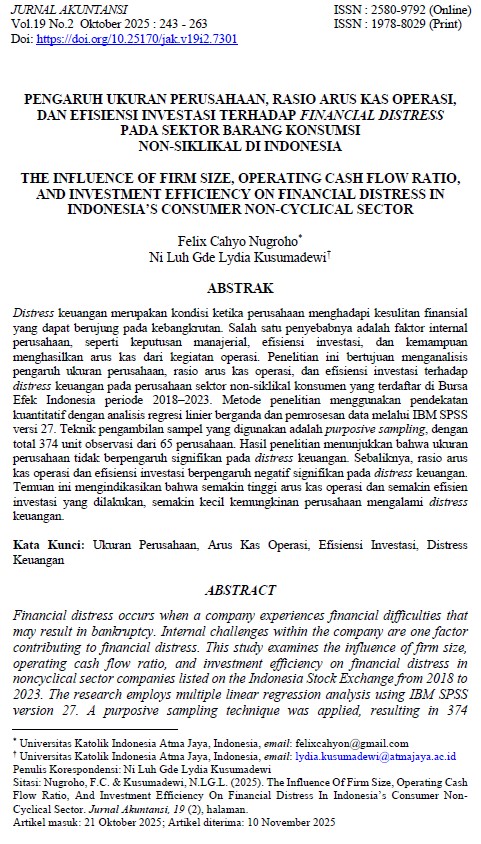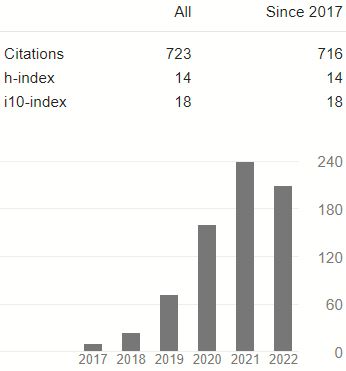THE INFLUENCE OF FIRM SIZE, OPERATING CASH FLOW RATIO, AND INVESTMENT EFFICIENCY ON FINANCIAL DISTRESS IN INDONESIA’S CONSUMER NON-CYCLICAL SECTOR
DOI:
https://doi.org/10.25170/jak.v19i2.7301Keywords:
Firm Size, Operating Cash Flow Ratio, Investment Efficiency, Financial DistressAbstract
Financial distress occurs when a company experiences financial difficulties that may result in bankruptcy. Internal challenges within the company are one factor contributing to financial distress. This study examines the influence of firm size, operating cash flow ratio, and investment efficiency on financial distress in noncyclical sector companies listed on the Indonesia Stock Exchange from 2018 to 2023. The research employs multiple linear regression analysis using IBM SPSS version 27. A purposive sampling technique was applied, resulting in 374 observation units. The findings indicate that firm size has no significant impact on financial distress. However, operating cash flow ratio and investment efficiency negatively affect financial distress, suggesting that higher cash flow and efficient investments reduce the likelihood of financial distress
References
ACCA. (2022). ACCA applied skills : financial management (FM) : Study text. Kaplan Publishing UK.
Apriani, D., & Ritong, F. (2024). Pengaruh ukuran perusahaan dan kepemilikan institusional terhadap financial distress. Jurnal Maneksi, 13(3).
Apriliani, M. T., & Dewayanto, T. (2018). Pengaruh tata kelola perusahaan, ukuran perusahaan, dan umur perusahaan terhadap kinerja perusahaan. Diponegoto Journal of Accounting, 7(1), 1–10.
Audina, B. P., Nurwulandari, A., & Nuridah, S. (2022). Pengaruh financial leverage, arus kas operasi, arus kas investasi, arus kas pendanaan dan firm size terhadap financial distress pada perusahaan manufaktur sektor tekstil yang terdaftar di Bursa Efek Indonesia. Jurnal Ekonomi, Akuntansi dan Manajemen, 1, 81–86.
Biddle, G. C., Hilary, G., & Verdi, R. S. (2009). How does financial reporting quality relate to investment efficiency? Journal of Accounting and Economics, 48(2–3) 112–131.
Bimo, I. D., Silalahi, E. E., & Kusumadewi, N. L. G. L. (2022). Corporate governance and investment efficiency in Indonesia: the moderating role of industry competition. Journal of Financial Reporting and Accounting, 20(2), 371–384. https://doi.org/10.1108/JFRA-12-2020-0351
Dewi, A. S., Arianto, F., Rahim, R., & Winanda, J. (2022). Pengaruh arus kas, profitabilitas dan leverage terhadap financial distress saat masa pandemi pada perusahaan manufaktur terdaftar di BEI. Owner: Riset & Jurnal Akuntansi, 6(3), 2814–2825. https://doi.org/10.33395/owner.v6i3.968
Fajriani, A., Yudhia Wijaya, S., & Widyastuti, S. (2021). Determinasi efisiensi investasi. KORELASI : Konferensi Riset Nasional Ekonomi, Manajaemen, dan Akuntansi, 2, 1541–1554.
Faldiansyah, A. K., Arrokhman, D. B. K., & Shobri, N. (2020). Analisis pengaruh leverage, ukuran perusahaan, dan arus kasterhadap financial distress. Jurnal Business Net, 3(2).
Fitriana, A. (2024). Analisis laporan keuangan (R. R. Hasibuan & S. Nurjanah, Eds.). CV Harto Malik Rizki Amanah.
Harto, B., & Napisah, L. S. (2020). Analisis pengaruh model laba dan model arus kas dalam memprediksi kondisi finansial distress (Studi pada perusahaan transportasi yang Terdaftar di Bursa Efek Indonesia 2015-2018). JRAK: Jurnal Riset Akuntansi Dan Bisnis, 6(2), 100–108.
Jensen, M. C. (1986). Agency costs of free cash flow, corporate finance, and takeovers. American Economic Review, 76(2), 323–339.
Jonathan. (2022). Pengaruh ukuran perusahaan, rasio leverage, profitabilitas, dan likuiditas terhadap financial distress pada perusahaan manufaktur yang terdaftar dalam Bursa Efek Indonesia Periode 2018-2020. Universitas Katolik Indonesia Atma Jaya.
Kartika, A., Abdul Rozak, H., Nurhayat, I., & Bagana, B. D. (2020). Rasio keuangan sebagai prediksi financial distress. Prosiding SENDI.
Kristanti, F. T. (2022). Financial distress: Teori dan perkembangannya dalam konteks Indonesia, 2. Inteligensia Media.
Mondayri, S., & Tresnajaya, Rd. T. J. (2022). Analisis pengaruh good corporate governance, intellectual capital, dan arus kas operasi terhadap financial distress. Jurnalku, 2(1), 25–43.
Nadya, K. (2023). Apa itu consumer non cyclical: Definisi dan contoh sahamnya di pasar modal. https://www.idxchannel.com/market-news/apa-itu-consumer-non-cyclical-definisi-dan-contoh-sahamnya-di-pasar-modal
Nickhole, N. (2023). Analisis pengaruh arus kas operasi, kepemilikan manajerial, dan profitabilitas dalam prediksi financial distress pada perusahaan manufaktur di Bursa Efek Indonesia Periode 2019-2021. Universitas Katolik Indonesia Atma Jaya.
Nilasari, I. (2021). Pengaruh corporate governance, financial indicators, dan ukuran perusahaan terhadap financial distress. Competitive Jurnal Akuntansi dan Keuangan, 2(5), 61–68.
Purba, R. (2023). Teori akuntansi : Sebuah pemahaman untuk mendukung penelitian di bidang akuntansi. https://www.researchgate.net/publication/369793571
Purwaningsih, E., & Safitri, I. (2022). Pengaruh profitabilitas, likuiditas, leverage, rasio arus kas dan ukuran perusahaan terhadap financial distress. JAE (Jurnal Akuntansi dan Ekonomi), 7(2), 147–156. https://doi.org/10.29407/jae.v7i2.17707
Purwanti, D. (2021). Determinasi kinerja keuangan perusahaan: analisis likuiditas, leverage dan ukuran perusahaan (Literature review manajemen keuangan). JMIT: Jurnal Ilmu Manajemen Terapan, 2. https://doi.org/https://doi.org/10.31933/jimt.v2i5
Ramadhani, R., Yuliani, Saputri, N. D. M., & Muthia, F. (2023). Prediksi financial distress: Analisis metode Altman Z-score, Zmijewski, dan Grover pada perusahaan sektor transportasi dan logistik. Widya Cipta: Jurnal Sekretari Dan Manajemen, 7(2), 207–217. https://doi.org/10.31294/widyacipta.v7i2.16108
Ramdani, E. (2020). Financial distress analysis using the Zmijewski method. JIMFE (Jurnal Ilmiah Manajemen Fakultas Ekonomi), 6(1), 69–78. https://doi.org/10.34203/jimfe.v6i1.2032
Richardson, S. (2006). Over-investment of free cash flow. Review of Accounting Studies, 11(2), 159–189.
Sahir, S. H. (2021). Metodologi penelitian (T. Koryati, Ed.). KBM Indonesia. www.penerbitbukumurah.com
Setiawati, S. (2023, October). Gawat! Pailit RI meningkat, ada 17 saham bisa gulung tikar. https://www.cnbcindonesia.com/research/20231019103510-128-481873/gawat-pailit-ri-meningkat-ada-17-saham-bisa-gulung-tikar
Venisa, & Widjaja, I. (2022). Pengaruh arus kas, profitabilitas dan solvabilitas terhadap financial distress. Jurnal Manajerial dan Kewirausahaan, 4(2).

Downloads
Published
Issue
Section
License
Copyright (c) 2025 Felix Cahyo Nugroho, Ni Luh Gde Lydia Kusumadewi

This work is licensed under a Creative Commons Attribution-ShareAlike 4.0 International License.
Authors who publish with this journal agree to the following terms:
- Authors retain copyright and grant the journal right of first publication with the work simultaneously licensed under a Creative Commons Attribution-ShareAlike 4.0 International License that allows others to share the work with an acknowledgment of the work's authorship and initial publication in this journal.
- Authors are able to enter into separate, additional contractual arrangements for the non-exclusive distribution of the journal's published version of the work (e.g., post it to an institutional repository or publish it in a book), with an acknowledgment of its initial publication in this journal.
- Authors are permitted and encouraged to post their work online (e.g., in institutional repositories or on their website) prior to and during the submission process, as it can lead to productive exchanges, as well as earlier and greater citation of published work.














